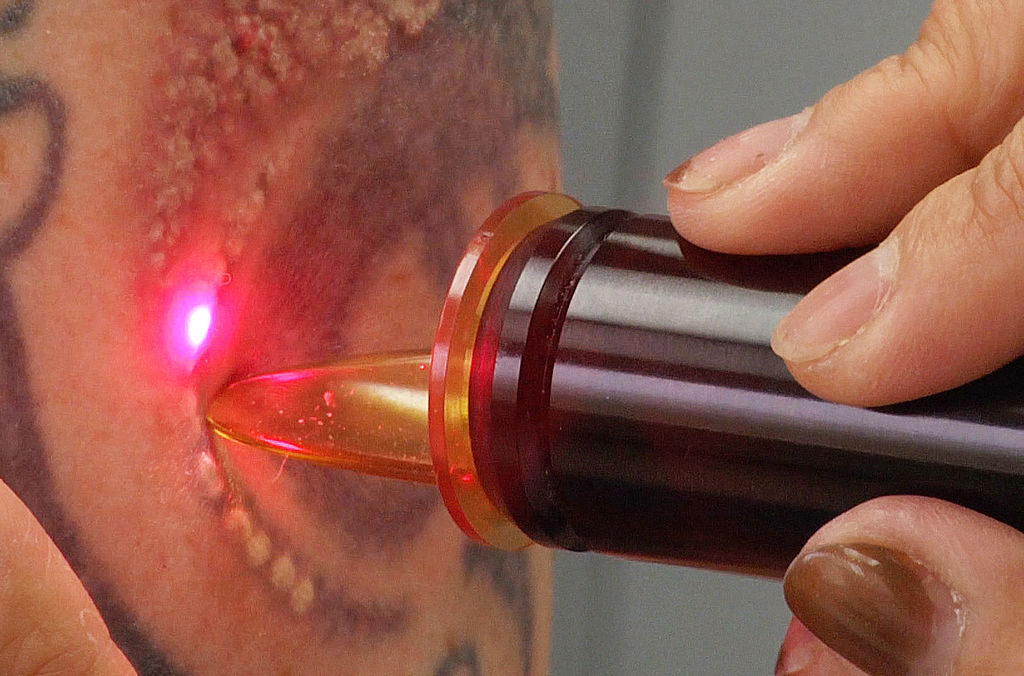Regretting that tattoo you decided to get a few years ago? Fear not; there are plenty of options for laser tattoo removal in London, and the procedure is much safer and more effective than it was a few years ago.
It’s thought that around 50% of people with a tattoo are keen to have it removed — if you’re one of them, there’s a few things you should know before you do.
What is laser tattoo removal?
You can have your tattoo removed in London by booking in to a specialist laser, dermatology or cosmetic clinic and booking a course of laser treatments.
This involved a laser breaking down the ink particles in the tattoo, allowing them to be reabsorbed into the body.
This video breaks down the exact stages of laser tattoo removal:
It’s not a quick fix, however; you’ll need multiple treatments for total removal and there’s still no absolute guarantee that the tattoo will be totally erased after all your treatments.
How long does laser tattoo removal take?
Although the standard guide is between 6 to 10 sessions, exactly how many you’ll need depends on a variety of factors. After a consultation, your laser practitioner should be able to estimate the number of sessions you’ll need for removal.
There are certain factors that affect the speed of tattoo removal:
- Skin type
- Colour – black and dark blue tattoos are much easier to remove than coloured ones
- Location – tattoos on the arms and legs will take longer to remove as they’re further away from the heart so ink reabsorption takes longer.
- Size
- Layering
- Scarring or tissue change – this can make tattoo removal harder
It’s no use trying to complete all your sessions within a short time frame either; ideally each session should be separated by around 7 weeks. Otherwise, you could risk skin problems and scarring.
Some people never achieve complete removal of their tattoo, even after completing all their sessions. They are likely left with a ‘ghost image’ or perhaps even some raised scarring.
Is laser tattoo removal safe?
Laser tattoo removal is a very popular and widely considered safe way to remove a tattoo. As with many medical procedures, a large part of what makes it safe is having an experienced and fully qualified laser practitioner carrying out the procedure for you.
Do you research on the best clinics for laser tattoo removal in London, and check out our guide to the best London laser clinics.
Progressive laser technology has ensured that laser tattoo removal has come on leaps and bounds in recent years with minimal side effects and a more effective treatment for a wide array of tattoos.
Ideally, you will want to be treated using a Q-switched laser which minimises any potential scarring side effects and provide a variety of wavelengths in which to treat a variety of colours.

Tattoo removal using a Q-Switch laser (by James Mutter – Creative Commons)
Side effects of laser tattoo removal
There are a few side effects of having a tattoo removed by laser but these are mostly rare and temporary.
Here are the possible side effects that you should be aware of:
- Hypopigmentation – the tattoo site becomes paler than the surrounding skin (usually corrects itself within a year). This is more common in people with darker skin tones
- Hyperpigmentation – the tattoo site becomes darker than the surrounding skin (usually corrects itself within a year)
- Permanent scarring, keloid scars or a change in skin texture
- Burns and blisters
- The tattoo site will be vulnerable to infection
Immediately after a treatment, you may experience some minor bleeding, redness, blisters, swelling and temporary hyperpigmentation. These should clear of their own accord although speak to your doctor if they’re still hanging around after two weeks.
Does laser tattoo removal hurt?
Obviously, this will depend on your own personal pain threshold, but the consensus is that laser tattoo removal does hurt — possibly a little more than getting the original tattoo did.
The sensation has been compared to multiple pulses of grease splatters or the repeated flicking of a hot rubber band. Most people manage to go without anaesthesia, although some clinics will offer a topical anaesthetic or local injections to numb the site.
Many practitioners will recommend you take some mild pain relief prior to the treatment to reduce discomfort. Make sure that you avoid aspirin and anti-inflammatory medication, however – the former thins the blood and the latter can produce increased bruising.

